It should come as no surprise that the sudden onset of COVID-19 has transformed the recruitment process overnight. While talent acquisition professionals and people teams are still adjusting to the new normal, a few salient trends have emerged.
Today, recruitment is almost entirely digital due to social distancing ordinances. As a result, careful communication with candidates is key — especially during a hiring lull. Nurturing prospects and keeping your talent pipeline engaged with thoughtful employer branding content is crucial to maintaining a presence among job seekers. Read on to explore other trends that have evolved this quarter as COVID-19 continues to unfold.
See how your employer brand is performing in AI tools like ChatGPT and Google.
Table of Contents
Q2 2020 Recruiting Trends

The Importance of Employer Branding
Perhaps the biggest shift to recruitment is the fact that many companies have paused — or at least reduced — their hiring efforts. The result is less competition for those actively hiring, and an urgent need for those facing a hiring lull to get creative. When you can’t extend an offer to candidates, how do you keep them interested and encourage them to remain available despite the delay? The answer lies in your employer branding strategy.
Never has the practice been so vital to recruitment marketing. Typically, three-quarters of job seekers consider a company’s employer brand before choosing to apply to a job. However, with the majority of the world stuck at home and online traffic on the upswing since the start of COVID-19, you can confidently assume that even more candidates are thoroughly researching your online presence and reputation.
Not only does effective employer branding entice potential candidates, it also helps keep your talent pipeline warm while your team adapts to the situation at hand. Seamlessly integrate compelling employer branding content into your candidate nurture campaigns to ensure your top prospects stay engaged.
At the very least, focusing on employer branding during this uncertain time will better position organizations for when the job market returns to normal. As more employers ramp up their efforts and individuals restart their job search, your employer branding efforts will have preemptively put your company on the map. Candidates will know who you are and be more open to your opportunities; they’re 40 percent more likely to apply for a job if they recognize a company’s brand.

Preparing for Remote Work
The transition to remote work is largely being viewed as a testing ground for more prominent telecommuting trends in the future. However, recruiters aren’t waiting until the dust settles to adjust accordingly: 84 percent of talent acquisition professionals are actively working to adapt their processes to work remotely.
Not only does this accommodation allow teams to continue hiring despite social distancing, it also allows them to cast a wider net when sourcing and open up their talent pool to multiple geographic locations. Ultimately, this can improve hiring outcomes and effectively reduce cost-per-hire.
Still, remote work opportunities are likely to remain popular among employees well after we return to the office. In fact, 43 percent of U.S. full-time employees already say they’d like to continue working from home after the economy reopens. It’s time to lay the groundwork for a long-term, permanent work-from-home policy. Even if you maintain an in-office presence when the world shifts back, being able to offer flexible work options will appeal to candidates and help you fill high-priority positions.

Increase in Webinar Traffic
Recruitment events are a great way to expedite the recruitment process and connect with candidates face-to-face. However, with social distancing at play, recruiters have been forced to adapt and webinars have become a central fixture in recruitment strategies. In March alone, the number of digital events hosted on the popular ON24 Platform increased 330 percent year-over year.
Webinars have become commonplace for multiple reasons. For starters, they’re the most fitting substitute for in-person recruitment events. Second, with many businesses struggling to keep up with the rapidly changing economy, webinars offer an excellent opportunity to share your knowledge with those who need it.
This in turn acts as an employer branding play, allowing you to highlight your strengths and leverage your people while benefiting members of your community. It also allows prospective employees to get a sense of your type of organizational culture and interact with your current team members, which 66 percent of candidates believe is the best way to evaluate a potential employer.

Virtual Onboarding and e-Learning
Don’t forget: onboarding is the final stage of the recruitment process and it begins the day a new hire accepts your offer, not their first day on the job. With human interaction removed from the equation entirely, recruiters and HR teams are pushing their efforts into overdrive to make remote onboarding as effective as the real thing.
And for good reason: a solid onboarding process can improve retention rates by 82 percent. A new hire’s onboarding sequence is their first official introduction to your company and team, which is why a poor experience sends 17 percent of new hires packing within the first three months on the job.
With the shift to remote work came a need for virtual learning, which requires video conferencing software and additional digital resources, such as employee engagement tools. E-learning platforms offer tailored training courses through a variety of formats that appeal to multiple learning styles. This allows you to provide comprehensive training that frees up your time to focus on customizing each new hire’s experience.
To give your newest employees the best shot at adjusting to the role and company, go out of your way to create virtual social opportunities that connect colleagues and support your company culture. In fact, incorporate engaging elements of your culture throughout the entire recruitment process to create a remote candidate experience that’s sure to capture the attention of top candidates.

Reprioritized Employee Benefits
With unemployment on the rise — there were 30.3 million first-time unemployment claims recently filed in the U.S. as of April 30, 2020 — employees are in search of stability and job security. While previous 2020 projections suggested that unlimited vacation would reign supreme among employee benefits, COVID-19 has changed all that. Today, remote work is the number-one most sought-after perk among employees, according to data obtained through our online communities.
While this seems like an obvious adjustment, it indicates that employee preferences are changing rapidly and businesses will need to adapt in order to stay relevant. Given the rise in unemployment statuses, job seeker behavior will only increase from here on out. Prospective employees will dedicate the time to purposefully seek out organizations that offer tangible support through a competitive benefits package.
On top of that, COVID-19 may render some of your existing benefits obsolete, such as catered lunches or prepaid gym memberships. Modify your benefits package immediately to avoid wasting a substantial part of your budget on unusable perks, and poll your current workforce to prepare for the long-term shift in benefits. This process of collecting feedback can be seamlessly automated through employee engagement surveys.
While these trends have emerged as crucial to today’s state of recruitment, things are bound to change as the COVID-19 situation continues to develop. Stay abreast of the evolving landscape and check back here for additional updates in Q3.
Q1 2020 Recruiting Trends
At the start of every year, companies begin opening up roles as annual budgets are re-allocated and growth goals are established for the year. For recruiters and HR professionals, January and February are known to be some of the busiest months of the year for turnover and hiring.
This update covers upcoming recruiting trends for 2020, from sourcing strategies to candidate matching as well as the top perks and benefits candidates will be looking for. We’ll also touch on ways to reboot your recruitment marketing strategy and prioritize diversity and inclusion throughout your recruiting efforts.
The new year has arrived. Job candidates who have spent the last few weeks finishing out the year at their current companies are eager to start looking for new jobs, if they haven’t already. Now is the time to really reel them in — show off all that your company has to offer while identifying top candidates for your pipeline before the competition. Nowadays, there are a wide range of tactics and tools you can use to attract job seekers. To help narrow your efforts, we’ve provided a few key areas to focus on.
SOURCING CANDIDATES

In order to recruit top candidates, you need to have an idea of where and how you are going to source them. Start by creating candidate personas for each of the roles you are hiring for — that includes the roles you plan to fill in the upcoming year. Then, you’ll be able to identify the best ways to source candidates.
During your research, also do a deep dive into where your competitors are sourcing their candidates. While there may be a lot of competing employers on top job boards, networking platforms and social media sites are sourcing opportunities your competitors may overlook. Finding these missed opportunities can be as simple as searching “job board for [insert role]” or “hiring [insert role].” Also, do research from a job seeker's perspective by searching phrases like “fintech jobs near me” or “tech jobs near me” or “best paying companies.” These type of searches will show you where candidates land when they are looking for jobs.
Additionally, the algorithms and trends that dictate who, where and when candidates discover information about your company are complex to say the least, so keeping up with them will help you stay ahead of the curve. You can do this by taking a class on sourcing, learning about SEO and understanding Boolean search.
CANDIDATE MATCHING

With how much time and resources go into building a talent community, it’s almost unbelievable that there isn't technology to automate all this work. Oh wait...there is, and it’s called candidate matching.
While candidate matching isn’t a new practice, advancements in artificial intelligence and smart matching technologies have sparked development of a few new tools that are just starting to make their way into the HR and recruiting sphere. These tools are able to recommend top candidates based on the criteria you have set in a job description, such as experience, skills and location to name a few.
As these tools continue to evolve over the next few years, they will only become more accurate and specific with their candidate recommendations. Companies that invest in such products today will be much more efficient at identifying top candidates before their competitors do, not to mention save a wealth of time and resources recruiting.
As the skills gap for high-tech roles continues to widen, the race to attract top tech candidates will only become more fierce, so anything to help source and connect with candidates more quickly will help companies beat out the competition for top talent.
PERKS & BENEFITS

Did you know 89% of 18-34 year old employees care more about great perks and benefits than they do about pay raises? But what perks and benefits could possibly be better than a pay raise? Trends indicate that, in 2020, the perks and benefits candidates will be looking for include: financial wellness, mental healthcare, student loan repayment, transgender-inclusive healthcare, technology benefits, family planning, flexible schedules, commuter benefits, paid leave and pet benefits.
It’s one thing to provide exceptional perks and benefits, but if candidates aren’t aware of them, it’s like they don’t exist. Here are a few ways that you can effectively communicate your perks and benefits to attract top talent:
Optimize Your Career Page
We mentioned earlier the importance of optimizing your career page for search engines, and this is a great example of why that is so important. Take this real life example from Salesforce. On Salesforce’s career page, they include a section about the perks and benefits they offer employees. They utilize specific keywords like ‘volunteer time off’ and ‘401(k) savings’ in their headers, which attracts traffic from candidates who search for those keywords with the company name as you can see below:
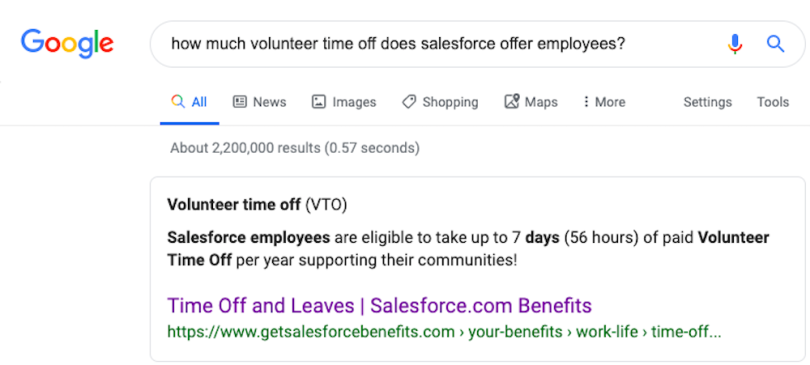
Because the company optimized the page for search engines, their career page is not only the first result on Google, but it is in a featured snippet box, meaning it appears before all of the other organic search results.
In this second search for ‘salesforce 401k,’ they didn’t get a featured snippet, but they are the first search result for that inquiry. Plus, they have anchor links below the meta description that provide even more specific information on the topic.
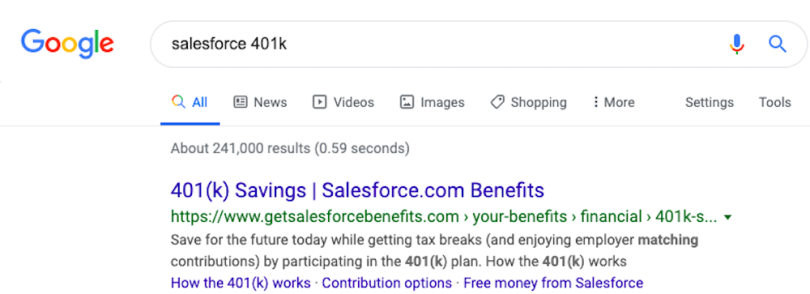
Share Perks & Benefits on Job Posts and Social Media
Anywhere that you share information about open roles, company culture and employer branding, you should also discuss your company’s perks and benefits. This will help distribute this information to both active and passive candidates early in the recruitment process — long before they land on your career page.
Utilize Platforms that Optimize for Perks & Benefits
While all of the major job boards and recruitment platforms allow candidates to search by job title, industry and location, none of them allow for candidates to search by the perks and benefits a company offers. Well, all but one. On each of Built In's eight local tech communities, there is an extensive navigation tool that allows candidates to search for companies based on their perks, tech stack, company size, funding and industry. We're not biased, but we've heard candidates are a big fan of this feature.
REBOOT YOUR RECRUITMENT MARKETING STRATEGY NOW
Once you know where and how you will attract candidates, you’ll want to start focusing on your recruitment marketing strategy. Why? Marketers have this concept called The Rule of Seven, which basically states that a prospect — in this case a prospective candidate — needs to come into contact with a brand — or employer brand — seven times before they recognize the brand and take action.
As candidates and companies are easing back into the new year after holiday breaks, it is a great time to create that stellar recruitment marketing and employer branding content you’ve been brainstorming about but haven’t had the time to do.
By working on your recruitment marketing efforts now, prospective candidates will be much more familiar with your company as a future employer when as the year gets busier, whereas your competition will be several weeks, if not months, behind.
RECRUITMENT EVENTS

Hiring or recruitment events are notorious among candidates for being boring at best and stressful at worst. But believe it or not, recruitment events are making a come back and in a big way — but not as your standard job fair or networking event.
Companies are getting more and more creative with their hiring events and how they incentivize candidates to attend. Companies have begun hosting events at hip, local restaurants or in their offices, offering free food and beverages, giving out free swag and providing fun and educational activities. Whatever you decide to do, it’s important to create an experience that reflects the mission and values of your company and culture. Create an event that your current employees would want to attend because it is bound to attract candidates that would work well with your culture. This also helps boost attendance among your current employees, which further reinforces the type of culture your company has and provides candidates with more opportunities to meet with their prospective colleagues.
Also, in a world where social media is one of the top sources for people to obtain and share information, making your event Instagram-friendly certainly isn’t going to hurt your employer brand. Provide attendees with cool swag that they will want to share with friends and sport in public; this will boost your employer brand and get people talking about the event and your company. Talk about grassroots recruitment marketing!
Above everything, you want to provide attendees with a memorable experience that makes them feel welcome to apply for a role or at least join your talent community to learn about future roles.
WHAT CANDIDATES EXPECT FROM EMPLOYERS IN 2020
There’s no doubt that millennials, and now Gen Zers, have significantly altered the workforce as we know it. Unlike generations in the past, they set high expectations for employers and don't care to establish a several decade career at one company. Instead, these generations care about companies that offer flexible work schedules and time off, create meaningful careers and promote diverse and inclusive workplaces.
If you don’t currently offer or promote any of these attributes, you need to take a critical look at the value you have to offer candidates as their employer. Let’s take a further look at how you can prepare for candidate expectations in 2020.
DIVERSITY AND INCLUSION

More than ever, candidates care if companies actually foster a diverse and inclusive (D&I) culture — so much so that two out of three candidates actively look for companies that have diverse workplaces. Not only that, but 85% of CEOs whose work cultures are diverse and inclusive notice increased profits.
While this is a major topic among recruiters and HR professionals, building a diverse and inclusive workforce doesn’t happen overnight. It takes months, or even years, of hiring the right employees and fostering a workplace where everyone feels welcome and included. And if you’ve pushed off prioritizing D&I until your company is bigger, you certainly haven’t done yourself any favors because changing a culture is significantly harder than building one.
No matter how much effort it takes, prioritizing D&I at your workplace is no longer optional — and it really never should have been. There are likely areas for improvement you haven’t considered before such as allowing candidates to share their preferred pronouns and asking them for feedback to make your application and interview process more accessible. By taking time to focus on D&I now, you’ll begin to notice improvements well into the new year so when candidates ask you about how diverse and inclusive your company is during the recruiting process (more than half of the candidates will ask about diversity and inclusion during the interview, by the way) you will be able to provide them with concrete evidence for how your culture is improving its diversity and inclusion efforts. You can even highlight your D&I efforts on your career page and social media channels.
Keep in mind that nobody expects you to be an expert on this complex subject matter, but it’s critical that you, as a person in HR and recruiting, continue to learn, grow and share insights with the company. And don’t feel like you need to do this alone. Start a diversity and inclusion committee or bring in an expert on the matter to get the ball rolling. For more ideas, check out how 13 real companies boost diversity and inclusion efforts at their company.
Q1 has just begun, meaning candidates are going to start rolling in the door as they set out to meet their ‘new year, new me’ goals. If you procrastinate much longer, you'll fall behind and start out the new year on the wrong foot. By starting early, your employer brand will be top of mind for both active and passive candidates long before your competition initiates their hiring strategy for the year.
Recruiting Trends - December 2019
This update covers hiring efforts during the holiday season as well as upcoming recruiting trends for 2020. We’ll also touch on the latest HR content to help you stay in the know over the holidays.
Candidates are coming to town

There’s a common misconception that companies are not hiring full-time positions during the holidays. However, that’s simply not true. Sure, hiring during the holidays is a bit more challenging with people out of the office and teams trying to meet their end-of-month, quarter and year-end goals, but there are also some advantages to hiring in December.
For starters, job seekers have more time to consider the future of their career path, research companies and apply to positions over holiday breaks. They may even network with friends and family as they catch up on their current workplace frustrations and interests.
Additionally, teams with surplus budget may look to hire quickly before the funds are reallocated in the new year. And for the teams that need to wait until next year to afford hiring new employees, December is the prime time to attract job seekers in preparation for 2020 recruiting.
All of this is to say that you should continue prioritizing your employer brand with a stellar recruitment marketing strategy throughout the chaotic month of December. In the season of caring and giving, remind candidates of your team’s mission and core values. Highlight company-sponsored charity work or donations to entice job seekers who share similar values.
Here are a few of your favorite things

If you’re like most recruiters, you’ve got a long list of items you’ve been meaning to get to but other priorities have prevented you from keeping up with the latest industry trends. With more downtime than other months, now’s a great time to dive into the list of best HR books for 2019 you’ve been eyeballing.
If you’re more of an auditory learner, see if there’s an audiobook version. You can also check out the long list of HR podcasts that have been developed in recent years and make a New Year’s resolution to stick with one or two favorites.
Now is a great time to catch up on your favorite HR newsletters and subscribe to some new ones. Additionally, go through and unsubscribe to any newsletters you no longer find valuable. Doing so will save you time in the new year and ensure you continue receiving content that pertains to your interests and needs.
Also, conduct research on any HR conferences in 2020 you want to attend. Some require RSVPs months in advance, so it’s worth spending the time to determine your top events and submit expense requests before the craze of recruiting and hiring starts up again.
Rocking around, recruiting trends

At the beginning of Q4, we covered the 10 recruiting trends to know for 2020, and as the quarter comes to an end, your preparations for hiring in the new year should still be in full swing. While you’re likely not able to take on any new major projects, you can continue to follow through and maintain your efforts to source candidates, build your talent pipeline and sustain your social media recruiting efforts.
While job seekers will be busy closing up projects and traveling for holiday celebrations, they will also have more time to relax and check social media. Because most employers will create generic holiday posts announcing their return in the new year, it’s a great opportunity for you to share stellar content and stand out with job seekers among the standard ‘happy holidays from us at ___’ posts.
With social media management tools today, you don’t have to continue sharing content at the expense of your team’s personal time and much deserved holiday leisure. Create a bunch of great content early in the month and schedule it throughout the holidays so your company stays top of mind when candidates are setting personal and professional goals for the new year.
However, there’s only so much you can automate and schedule. Create a plan for your team to take turns checking social inquiries and applications so that job seekers putting in the effort to apply don’t go unnoticed.
Consider sending a “wake-up” email to everyone in your talent community just before the holidays kick off to reengage top candidates who have already shown interest in your company. If you have the bandwidth, host a holiday recruitment event to expedite candidates through your pipeline and get them excited about your 2020 business plans.
Recruiting Trends - November 2019
This update covers recruiting trends from a 30-hour work week to standing out with creative job descriptions. We’ll also touch on the state of cover letters in an age of social media and a candidate-driven market.
Do We Really Need 40-Hour Weeks?

In recent news, Microsoft changed up the standard work week in Japan. For the month of August, it reduced the working days to just Monday through Thursday and kept the normal eight hour work days and full compensation. This test was part of its larger experiment coined Work-Life Choice Challenge, which was implemented in an effort to boost creativity and productivity all while improving employees’ work-life balance. The results were eye-opening. In this brief, one-month experiment, productivity rose by 40% compared to August 2018 numbers.
Now, the concept of shorter work weeks is not a novel idea. Back in 2016, Amazon piloted a 30-hour work week for salaried employees and allowed them to receive the same benefits, but with a 75% reduction in pay.
How did the 40-hour work week become the standard expectation for employees in the United States? In 1940, Americans worked anywhere from 80-100 hours each week. In the 1920s, Henry Ford discovered that employees were only slightly more productive and burned out quicker when they worked more than 40 hours. Then in 1940, the U.S. government passed the Fair Labor Standards Act that limited employees to work 40-hour weeks unless they are paid overtime.
Global workplace practices and expectations vary from the U.S. standard. Sweden-based digital marketing agency Brath offers employees full pay and benefits for working six hour days, and they observe higher retention rates and productivity. In fact, compared to 18 European countries, American employees increasingly work more each year — spending more time at the office and taking fewer vacations.
Perhaps it’s time the United States reconsider our 40-hour work week that was set as the standard nearly 80 years ago.
Tempt Candidates with Creative Job Descriptions
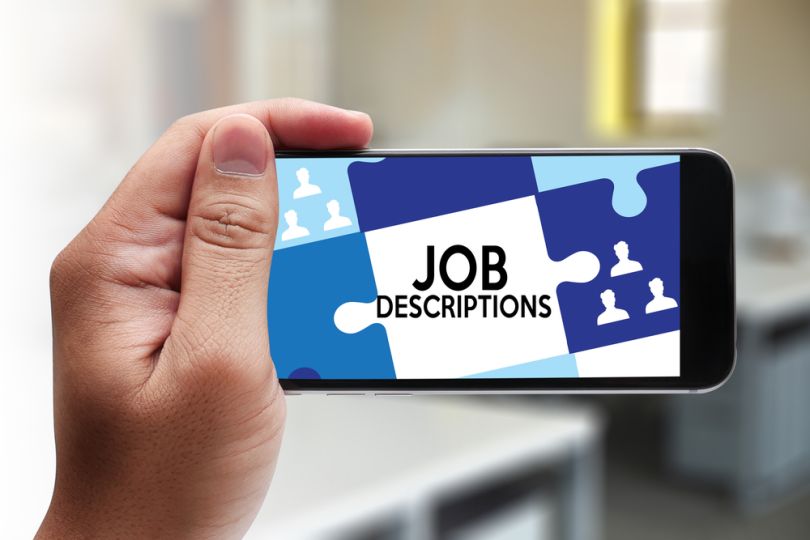
In a candidate’s market, employers must dazzle job seekers and stand out from competitors. Since the job description is one of the first touch points a candidate has in the job search, it’s crucial to make it memorable and enticing enough to actually apply. Not only that, but job descriptions are notorious for being mundane and formulaic, so why not switch it up?
Jaguar, for example, created this “Next Generation Recruitment” video that challenges candidates to “prove yourself,” suggesting that coding skills are more valuable to the role than professional experience. Similarly, Google created a billboard ad challenging job seekers to solve a riddle for a chance at an interview. Both of these companies found creative ways to encourage highly talented and competitive candidates to engage with their company as a future employer. These challenges also save candidates and employers the initial formalities of submitting and reviewing application materials.
If creating a challenge like Jaguar and Google did isn’t feasible for your organization, here are some more achievable examples.
Earlier this year, Twitter put out an ad for their next Tweeter in Chief, and while they posted a traditional looking job description, they put some spunk into the standard expectation and requirement sections. It’s a lot more fun to read than your typical job description, and it reflects the personality of Twitter’s company culture.
Additionally, some companies have completely redesigned the look of their job descriptions. They’ve done this by creating infographic job descriptions to make the job ad more visually appealing and easier to skim. If candidates are looking at multiple roles in one sitting, an infographic breaks up the noise, making your company stand out from the rest.
There are a ton of ways to create clever job descriptions and encourage candidates to apply. Talk with your team to determine a strategy that is true to your employer brand and targets your ideal candidate persona.
Who Actually Reads Cover Letters?

Let’s be real. If you were to receive 50 applicants and each of them submitted a resume and a cover letter, are you actually going to read through both materials for every candidate? Resumes are great for recruiters because they are designed and written to be skimmed — whereas cover letters are often overlooked entirely by recruiters. Plus, if a resume or social media profile contains all of a candidate’s work history, why are recruiters still asking for cover letters?
Most cover letters are uniform, and by the time it’s been edited and refined by colleagues and career professionals, it hardly reflects the personality and writing ability of the candidate. Unless you’re a job coach, nobody writes in the style of cover letters for their profession, so it’s a poor assessment of writing skills.
There is an argument for cover letters as a means to test a candidate’s writing ability, but if that’s the case, you should ask candidates for a writing sample that reflects a style that aligns with the job. And if the position does not require writing skills, ask for other more practical materials like a portfolio or skills test. Eliminating unnecessary application materials will encourage candidates to apply, save you time in the process and not only that, but simplifying your application process will ultimately reduce your time-to-fill.
Recruiting Trends - October 2019
This update covers recruiting trends from hiring Generation Z candidates to creating a workplace that’s accommodating for both introverts and extroverts. We’ll also touch on the evolution of voice assistants and their role in the HR industry and why there’s an urgent need to provide elder care benefits.
“Hey Google, Find Me A Job”

While voice assistants are more commonly associated with personal devices and smart homes, they have also proven to help employees complete tedious tasks. For recruiters and HR professionals who are in constant communication with candidates and employees to schedule meetings and interviews, such assistants can save them a wealth of time and energy.
Reward Gateway, an employee engagement platform, also hopped on the voice assistant bandwagon, creating a resource compatible with voice assistants that provides HR professionals access to information on employee engagement, perks and benefits and company updates.
Individual voice assistants have evolved to support different needs that are helpful for HR professionals, like “Hey Google’s” G-Suite calendar integration to keep track of meetings, interviews and hiring managers’ schedules across the company. And if you use platforms that integrate with G-Suite, you’ll likely have access to that information as well.
Voice assistants aren’t just helpful for employers and HR professionals. Job seekers and candidates are now able to apply for jobs at McDonald’s through the company’s new McDonald’s Apply Thru™ integration. Amazon Alexa users simply ask “Alexa, help me get a job at McDonald’s,” and the device will ask them a few questions to begin the application process.
Not only that, but employees are able to use applications like Ceridian’s Dayforce Assistant, that allow them to trade shifts with other employees, set meetings and communicate with team members all through voice assistant apps like Alexa and Siri.
Whether you’re an HR professional, recruiter or employee, voice assistant apps are quickly integrating into our workplaces, boosting productivity and communication all while reducing the routine tasks that previously consumed a significant chunk of the day.
Navigating Gen Zers In The Workplace

While millennials have gained the reputation for being disloyal to employers, lazy workers and fiscally irresponsible, Gen Zers are stereotyped for ghosting employers, being dependent on technology and preferring job security over high salaries.
Due to their experiences growing up in families where parents and siblings struggled during the 2008 financial crisis, Gen Zers are heavily concerned with job security and future employment. They also are more interested in working for companies that offer mentoring and growth opportunities than high-paying roles.
And while they value job security, Gen Zers are not afraid of setting even higher standards for employers than previous generations, going so far as to ghost employers when better opportunities arise. It also helps that unlike millennials, Gen Zers entered the workforce when unemployment rates reached all-time lows and employers have upped their perks and benefits packages to retain talent.
Gen Zers are also known for supporting brands that align with their personal values. Similarly, when it comes to applying for jobs, they’re interested in working for companies whose employee value proposition aligns with their personal values.
In terms of recruiting, younger candidates are not looking at newspaper ads for job openings. They’re searching for employer brands on social media and utilizing tools like voice assistants to apply for jobs. With each generation, the recruiting sphere changes drastically, which is why it’s important to stay in tune with your target candidate audience and how their needs and wants evolve over time.
The Growing Need For Senior Care Benefits

More than one in six employees also support elderly loved-ones outside of their normal job. Their roles can vary from providing transportation to administering vital medicine and such support may be needed for months, if not years. For full-time employees, these additional responsibilities can bring stress, depression, absenteeism and burnout.
As people have fewer children and life expectancies grow longer, the need for elder caregivers is rapidly growing. For families that can’t afford to fork out between $20-90k per year for caregiver services or senior care facilities, taking on the responsibility of caring for a loved-one is often the only option.
On average, employers lose nearly $13.4 billion each year in health care expenses as a result of employee burnout due to performing caregiving duties outside of work. Not to mention the loss in productivity for employees who need to take on average 6.6 days off/year or who are unable to perform at work due to caregiving-related obligations.
Just 17% of employees have access to paid family leave (which covers parental leave but not necessarily other family medical leave), and while 89% of workers have access to unpaid family leave, covering the costs of caregiving as well as their own expenses while progressing in their career is extremely difficult on a zero-income budget.
Employers can play a significant role in supporting employees and their families by offering benefits that allow them to balance work and their personal lives. Such benefits include:
-
Resources for geriatric care specialists and home adaptation
-
Insurance plans with low-cost in-home care
-
Flexible/accommodating work schedules
-
Discounted long-term care insurance
-
Employee assistance programs
-
Dependent care assistance
-
Employee resource groups
-
Counseling services
-
Support groups
-
Care subsidies
-
Respite care
Is Your Company Culture Introverted Or Extroverted?

You answer should really be both because introversion and extroversion are opposite ends of a spectrum. For reference, introverts tend to prefer quiet, low-stimuli workplaces and interacting with small groups, whereas extroverts tend to prefer background noise, higher-stimuli and regularly interacting with colleagues.
In workplaces that gear more toward one type of work-style, employees with opposite personality traits may become stressed, disengaged and burnt out.
If you’re unsure of the type of ‘personality’ your company culture has, ask your employees to take a personality questionnaire that can provide insights into their personal and work preferences. You may even notice some trends, where people with certain personality types gravitate towards certain roles or departments, which can help you make broader accommodations rather than individual.
As part of your diversity and inclusion initiatives, know that you undoubtedly have both introverted and extroverted members on your team, but if your culture caters to one or the other, it won’t be inclusive for different personality types. Know that most people are a mix of both, so it’s important to provide a spectrum of environments, communication-styles and meeting types.
Recruiting Trends - September 2019
This update covers recruiting trends from monitoring employee behavior to writing equal opportunity job descriptions and reporting sexual harassment in the workplace. We’ll also touch on the evolving workplace as the ‘work hard, play hard’ Gen Xers enter later stages of their careers, and the laid-back millennials gain influence on workplace standards.
Employers see, hear and know everything

Employers will try just about anything to improve the performance of their employees. In the days of yesteryear, employers would rely on managers and best practices to optimize employee performance, nowadays, employers are investing in technology to monitor a variety of different data points that are indicative of employee performance and engagement.
Believe it or not, it’s totally legal for companies to monitor the activity of employees on company computers, phones and the internet, including email content, screens and even keystrokes. And for the most part, companies don’t even have to tell employees that they’re being monitored. IT departments can even install bugs in computers, heat and motion sensors around the office and cameras to gather information on employees.
Technology is also becoming more and more attuned to language and emotional cues giving companies the ability to pinpoint certain conversations on company email and instant messaging apps that could indicate an employee is unhappy, disengaged or planning to leave the company.
Before you go all in on employee monitoring systems, you should be aware of the challenges and legal concerns that come with tracking information about employees, such as employee stress, workplace distractions and employee retention/turnover.
Work healthy, play healthy

Having been raised by Generation X, notorious for its ‘work hard, play hard’ motto, millennials were largely impacted by overworked parents, as well as the 2008 financial crisis. Contrary to their parents, millennials are stereotyped as lazy, selfish, disloyal and tech-obsessed. While these are broad and brash observations, there seems to be some truth to them, and if these polar mindsets merge, employees have the potential to find a happy medium when it comes to work-life balance.
As we mentioned in the March trends section of this article, Americans are working longer hours than ever before — so much so that 50% of Americans are self-proclaimed workaholics. A study from 2014 found that more than a third of Americans work at least 45 hours per week, and as of 2018, more than 9 million Americans work 60+ hours each week.
This trend set by older generations, however, isn’t catching on in other leading countries across the globe. Many companies in Europe established a different set of standards for work-life balance, encouraging employees to take several weeks off of work each year.
With millennials — and their ubiquitous mindset — taking over the workforce, some U.S. companies are scaling back their ‘work hard, play hard’ expectations as well as other notorious ‘workaholic’ cultures. Back in 2016, in an effort to be conscientious of different employees’ needs, Amazon launched 30-hour work weeks for some of its employees, providing them with the same benefits as 40-hour week workers.
Also, with unemployment rates at an all time low, candidates now have the luxury to set high standards and be selective with the employers they choose to work for. The top benefits millennials look for are indicative of the changing times, as they expect companies to offer unlimited PTO, flexible work schedules and wellness benefits.
Hopefully over the next couple decades of both generations working together, they will flush out a middle ground of working enough and actually taking time off for no specific occasion, to set the next generation up for a life of real work-life balance.
Are your job descriptions impartial?

There’s no doubt that job descriptions are tough to write, but have you ever considered that your job descriptions may actually dissuade certain candidates from applying?
For starters, there has been a buzz in the HR and recruiting world around how certain language attracts (or deters) certain candidates. It’s been found that men and women interact with the workforce and recruiting lifecycles differently. More specifically, one study found that masculine words, commonly found in job descriptions, dissuade women from applying for jobs.
If you’re looking to attract more gender-diverse candidates, check out tools such as Textio, which has helped companies hire more diverse talent simply by rewriting the language in job descriptions to be more gender neutral. Another simple (and free) tool is the Gender Decoder, created specifically to help companies identify gendered language in their job descriptions. Also, make sure to check for little things, like gendered pronouns to describe the candidate and include perks, benefits and salary that may help individuals with different personal situations better select the next company they work for.
Additionally, women are known for only applying to jobs when they meet 100% of the requirements, unlike men who apply with only 60% of the requirements. Eliminating non-essential requirements from the job description will encourage more women and candidates who haven’t had the same experiences and opportunities to apply.
Help employees report sexual harassment at work

Yes, it’s 2019. But that does not mean workplace sexual harassment is a thing of the past. Every year, more than 300,000 Americans are sexually assaulted or raped. While anyone is at risk for sexual harassment, 9 out of 10 rape victims are women.
What’s more, 12% of survivors experienced harassment in their place of work, and roughly 25% of women reported harassment at work. This doesn’t, however, include the 70% of women who have never reported their assaults.
Since the #MeToo movement grew virally in October 2017, survivors of sexual harassment have become more outspoken about the assaults. Between 2017 and 2018, sexual harassment reports rose 18%; but at the same time, the follow-up rate for such reports dropped by 12%.
After coming under scrutiny for harassment complaints, organizations like Google, McDonald’s, Intel, Lloyd’s of London and even celebrity activist Emma Watson created anonymous sexual harassment hotlines as an outlet for employees to report incidents anonymously without having to involve Human Resources or colleagues. And of the companies that offer anonymous hotlines for employees, 89% of them are found to be an effective resource.
Hotlines aren’t the only resources companies can invest in. There is a growing number of anonymous services, tools and apps that companies can utilize to help their employees come forward about misconduct and obtain the necessary resources for reporting and healing.
For more resources, SHRM created a list of 80+ sexual harassment companies and businesses, plus 5 tips for battling workplace harassment.
Recruiting Trends - August 2019
This update covers recruiting trends from retraining and retaining current employees to hiring older workers and mitigating unconscious bias in the recruiting process. We’ll also touch on the challenges and benefits of optimizing an open office design.
Retrain and Retain

In a world where tech is evolving faster than textbook companies can write and print new materials, it’s almost impossible for workers outside of education to keep up-to-date with new technology, software and trends. As the high-tech skills gap continues to grow, rather than letting go of employees with outdated education and skills, companies are instead providing them with continued learning and skills training to retain talent.
It’s estimated that in the next 10 years, 40% of US jobs are expected to decrease due to automation and smarter technology, especially in the office support, food service, production work, customer service and retail sales sectors.
As we embark on the Fourth Industrial Revolution, creating adaptable individualized training opportunities will be key to building a successful workforce that continues to grow with technology, and a few of the top US employers are starting to adopt such initiatives.
Amazon recently announced that it is investing $700M to retrain one-third (100,000) of its US employees by 2025 by teaching them high-tech skills. When you consider it costs around $50K to recruit, hire and train a new software engineer, it’s well worth investing in training your current employees. Similarly, Microsoft created a program that partners with other companies to train US service members and veterans for careers in technology.
Age is but a Number

With CEOs under the age of 40 running some of the most powerful companies in the world and employees preferring bosses under 30 to bosses aged 70+, ageism in the workplace is more prevalent than ever before. But if there’s one thing older employees have over the young guppies, it’s experience — a skill set and knowledge base that only comes with age.
Common misconceptions about older workers include a skills gap, a soon approaching retirement and an unwillingness to have younger managers — none of which are remotely true.
First of all, employees aged 50+ are actually the most engaged employees in the workplace. Additionally, roughly 47% of people exit and re-enter the workforce between 55-64 years old and 40% of employees currently report to a boss who is younger than them.
Also, the average life expectancy has increased by nearly 20 years since 1960, meaning more people are cashing in on social security for longer or are burning through their retirement funds. These trends are contributing to cultures like that found in Japan, which has noticed that more and more 75+ year old workers making their way back into the workforce.
Companies like GM and CVS have created programs that help older candidates land jobs with training opportunities that bring them up to speed on current workforce trends and technology. Such programs help older employees remain in the workforce longer, which helps to bridge the gap between longer life expectancies and dwindling retirement and social security funds.
Optimize Your Open Office

In the early 20th century, a famous architect, Frank Loyld Wright, became one of the first people to oppose walls and rooms, instead preferring the “spaciousness and flexibility of an open plan.” Now, about 70% of offices have adopted the open office concept to both break down social barriers as well as pack more people into the same amount of space.
While open offices continue to grow in popularity, companies have noticed changes in workplace behavior, including:
-
70% less face-to-face time between employees
-
22-50% increase in email use
-
86 minutes lost in productivity each day
-
62% more sick days
In order to combat these challenges and keep the cost effective, more social environment that open offices foster, companies are adapting their offices to offer activity-based working (ABW) to improve employee satisfaction and productivity. ABW offices allow employees to utilize different working areas depending on their type of work and fluctuating personal preferences. Creating soundproof pods, casual eating and socializing areas, non-schedulable huddle rooms, flexible seating options and quiet areas for heads down working.
Mitigate Candidate Bias

Unfortunately, bias is part of human nature. However, when people are aware of their biases, they are better able to reduce unfair and inaccurate inclinations towards others. When hiring new employees, it’s crucial for your hiring team to be acutely aware of biases they may have toward different candidates.
Some of the most common biases include:
-
Confirmation bias: Asking a candidate questions that will confirm your belief in someone else.
-
Affect heuristics: Judging a candidate’s ability to do a job based on superficial evidence.
-
Expectation anchor: Basing a candidate’s credibility on a single factor.
-
Affinity bias: Preferring a candidate because they are similar to you.
-
Intuition bias: Simply trusting your gut feeling about a candidate’s ability to do the job.
To better understand these biases and how they apply to you as well as your team and the individuals they are recruiting, it’s important to bring in an outside resource to educate your team about different biases and how to prevent them from influencing the recruitment process. There are a few simple things you can do to prevent bias, such as
-
Read resumes without personal information like name and address.
-
Conduct phone interviews or blind interviews where you can’t see the candidate or their mannerisms during the initial conversation.
-
Market recruiting efforts to diverse candidates from different backgrounds to bring in a range of candidates.
-
Script part of the interview so it’s standardized and all candidates are asked the same questions that aren’t directed by bias.
-
Edit job descriptions to ensure you are not unconsciously writing for a specific type of candidate demographic.
-
Set diversity goals so that you’re constantly reaching out to candidates with different backgrounds and experiences from those on your team.
Learn more about how 17 companies combat bias when recruiting diverse candidates.
RECRUITING TRENDS - July 2019
This update covers recruiting trends from disability and inclusion in the workplace to working weekends and offering tuition reimbursement benefits. We’ll also touch on a few trends related to hiring diverse candidates.
Diversity, Disability & Inclusion

As of July 2018, less than a third of Americans with disabilities between the ages 16-64 are in the workforce — for reference, 75% of Americans without disabilities are in the workforce.
The benefits of building an inclusive environment and hiring people with disabilities extend far beyond the individual employee. According to one study, if 1% more people with disabilities joined the workforce, the GDP could see a $25B increase.
Accenture Research conducted a study that measured 140 US companies by financial performance in terms of profitability and value creation. Of the companies analyzed, 45 were identified as “Champions” or leaders in disability employment and inclusion, and they saw a major lift in profitability and performance. Over four years, these companies saw an average of 28% higher revenue, doubled their net income and enjoyed 30% higher economic profit margins.
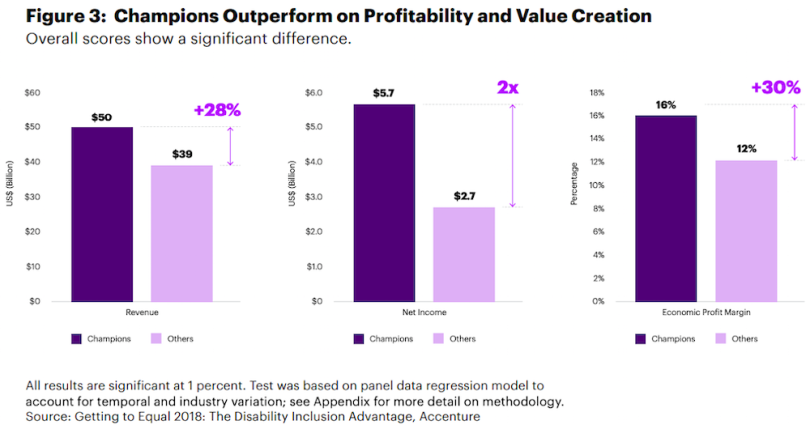
Hiring individuals with varying disabilities and experiences will not only help your team build a more diverse and inclusive environment, but those individuals will bring unique perspectives and ideas that will further help your company reach a wider market of customers and clients.
If you’re not sure where your company stands with disability inclusivity, see how it compares with the national Disability Equality Index. Some simple ways to boost disability inclusivity at your office and throughout your hiring process include:
-
Create a mental health allyship program
-
Establish an Employee Resource Group (ERG)
-
Provide comprehensive health benefit packages
-
Partner with disability advocacy groups
-
Make your website and application process accessible
-
Create an internship program for people with disabilities
To further improve disability inclusion hiring efforts, check to see if disability is included in your Equal Employment Opportunity statement and how it defines disability. Also, if your company has any resources for persons with disabilities, see if that information is included on your careers page and job descriptions.
Here are a few resources for hiring people with disabilities:
As well as a few job boards:
- Ability Jobs, Disability Job Exchange, Recruit Disability, Getting Hired, Ability Links, Respect Ability
Sunday Night Grind

Unlike 134 other countries, the United States currently has no laws prohibiting people from working a certain number of hours a week. For hourly employees, working over 40 hours/week guarantees them time and a half pay, but for salaried employees, overtime is compensated with the prospect of pay raises, bonuses and promotions.
While it’s one thing to work overtime during the work week, it’s another thing to take on work over the weekend. To some people, it’s cut and dry — weekends are exclusively for personal endeavors, but others find weekends to be their most productive and creative working hours. Working during the weekend can also provide individuals with a more flexible work-life balance throughout the week.
In order to shine some light on this heavily debated topic, Productivity Theory and iMPACT have narrowed down the Do’s and Don’ts of weekend work. Here are just a few:
-
Assess your work-life balance priorities
-
Communicate your working preferences to colleagues and be consistent
-
Respect your colleagues weekend work preferences
-
Set boundaries and limits on when, where and how long you work
-
Learn when and where you’re most productive
Also, be aware of the very real downsides and health concerns that come with working during weekends. In particular, one study found that men who work weekends are more likely to adopt symptoms of depression. Learn more about other mental health concerns at work in the April section of this article.
From Incarcerated to Employed

The unemployment rate for people ages 25-44, who have formerly been incarcerated, is more than five times higher than the national average. With national unemployment rates reaching record lows, companies are scrambling to find new talent sources to fill the gaps. Sounds like a match made in heaven, right?
If only the solution to these two problems was so simple.
While some states incentivize companies to hire candidates with felony convictions by offering tax breaks, other states continue to allow employers to require criminal history on job applications, perpetuating issues of social bias. In recent years, politicians from both sides of the aisle have made efforts to support incarcerated individuals from Obama’s Fair Chance Business Pledge (2016) to Trump’s First Step Act (2018).
One organization looking to help individuals with criminal records get back on their feet is The Last Mile, a prison education program that offers software engineering training in men’s, women’s and youth facilities in five states across the nation. The organization has even partnered with Slack to train and place three quality-engineering apprentices.
Edovo is another tech company that supplies incarcerated individuals with free access to rewards-based education programs and more affordable communication to friends and family. Facilities that use their tech have seen a decrease in violence and recidivism rates, and they’ve helped these individuals better prepare for life and work outside of prison.
Aside from lowering recidivism rates and helping to fill the employment gap, organizations like The Last Mile and Edovo are altering the cultural perception and stigma of formerly incarcerated individuals.
For more information on organizations you can partner with to help formerly incarcerated individuals re-enter employment, check out the National Criminal Justice Incentives Map to find an organization near you or simply reach out to the Federal Interagency Reentry Council. You can also find ways for your company to volunteer, advocate for or donate to re-entry organizations and employers through United Way.
Student Loan Benefit

The notion of tuition reimbursement as a work benefit is nothing new. In fact, more and more employees — particularly those with copious amounts of student debt — expect employers to offer this benefit and are even taking it into account when considering job offers.
Companies like McDonald’s, Chick-fil-a, Chipotle and Starbucks offer tuition benefits to employees as soon as 90 days after they start, regardless of their role with the company. Given the popularity of this benefit, you may ask why all major companies and thriving startups aren’t doing the same? Well, let’s look at some logistics.
On the IRS website under Exclusions from Income, it clearly states that:
“If you receive educational assistance benefits from your employer under an educational assistance program, you can exclude up to $5,250 of those benefits each year. This means your employer should not include the benefits with your wages, tips, and other compensation shown in box 1 of your Form W-2.”
Employers who offer this benefit — which is tax deductible for the company and not considered taxable income to employees — actually end up paying very little if the benefit is within the $5,250 margin.
Tuition assistance isn't just to the benefit of the employees. Accenture conducted a study on the health insurance company Cigna to measure the ROI on tuition assistance programs. They found that for every $1 they spent on their education reimbursement program, they both earned $1 back and saved $1.29 on recruiting costs and employee turnover.
But before you get too into the weeds, know that there are a number of factors to consider before implementing a tuition reimbursement program, so make sure you’ve done your research both logistically and legally.
Recruiting Trends - June 2019
This update covers recruiting trends from working fathers and paternity leave policies to recruiting recent graduates and celebrating LGBTQIA+ Pride Month in the workplace. We’ll also touch on a few trends related to the hiring and on-boarding process.
School Is Out, Applications Are In

The 2018-19 academic season is nearly over, and with graduation season coming to an end, the newest pool of fresh candidates are set to embark on their career path. Compared to 2007-08, the 2019-20 graduating class is expected to see an increase in Associate (30%), Bachelor (23%), Master (34%), Doctorate (54%) and First-Professional (34%) degrees.
The fastest growing jobs for grads are interestingly not the same among men and women. For women it’s Web Designer, Data Developer Engineer, UX Designer and Product Manager. For men, it’s Software Tester, Test Developer Engineer, Research Analyst, Investment Portfolio Manager and Information Security Specialist.
The majority of post-secondary graduates are reigning from the infamous Generation Z, a generation with an exceptional thirst to learn and a lifetime of familiarity with technology. These post-millennials are catching the attention of tech and consultancy companies, who are the top industries with open entry-level roles and internships for new grads.
There’s no doubt that internships are among the best opportunities for companies and talented individuals to gain professional experience, especially for students and recent graduates new to the workforce. Some companies are even testing out mico-internships or project-based internships that last only a few days or weeks, and allow candidates to test out a role before fully committing and allow companies to see how interns perform before offering a job.
After hiring an ambitious grad, companies are fostering their early career growth with continuing education and mentorship opportunities. It may be timely and costly hiring inexperienced candidates, but with the right growth, these career starters could be running your business.
Optimize The Candidate Experience

Remember when you had that negative candidate experience? Maybe the application process took too long, the recruiter ghosted you or perhaps the interview went horribly wrong. Those experiences stick with candidates and can be detrimental to your brand and reputation.
The majority of candidates research a company before applying, and in doing so, they’re seeking information about values (44%), culture (37%), employee testimonials (37%), why people work there (33%) and cultural diversity (20%). When creating a recruitment marketing strategy, give the candidates what they want early in the process.
More than ever, companies are relying on technology to complete repetitive tasks, like answering FAQs and scheduling interviews. While this may be convenient, critics are concerned that removing too much human contact may leave candidates frustrated and dissatisfied during the application process.
Additionally, it’s crucial to respect candidates’ time, provide a timeline and prepare for the interview as much (if not more) than they do. Candidates also greatly appreciate personalized rejection letters that offers constructive feedback to each individual who spent the time researching and applying to your role.
Above everything, the key factors that contribute to a candidate having a positive experience with an interview or during the recruiting process include:
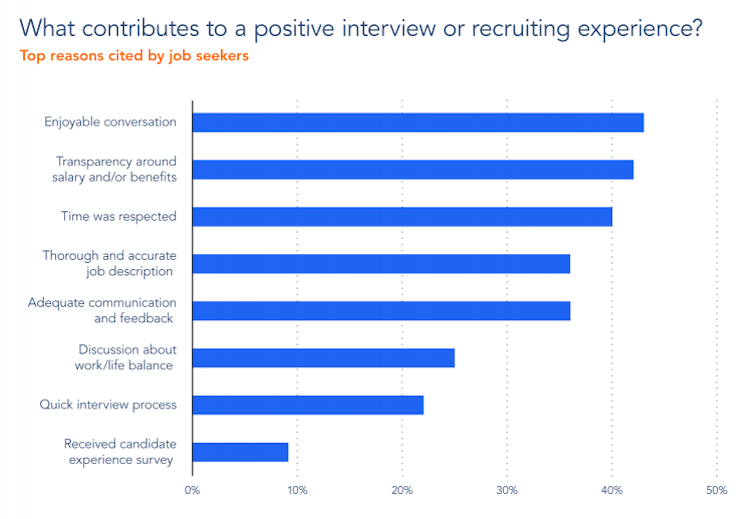
On the other hand, the factors that contribute to a negative interview or recruiting experience are almost entirely preventable… all except not liking the recruiter/hiring manager’s personality.
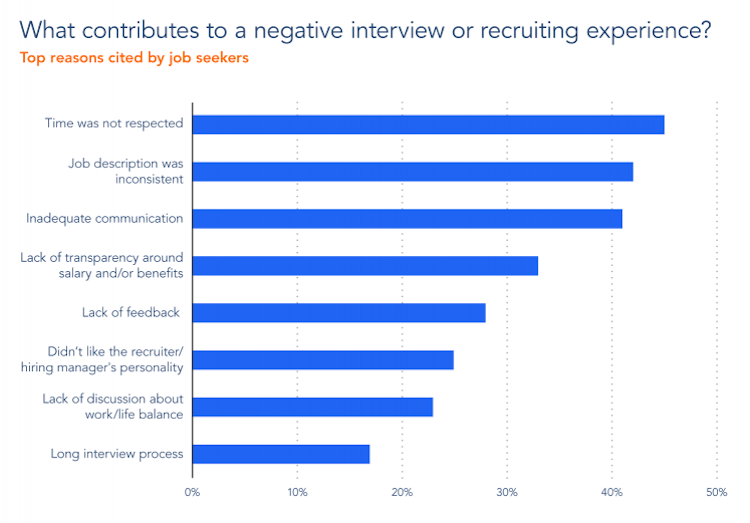
Celebrating Pride in Corporate America

It’s June 2019, which means it’s the 50th anniversary of the Stonewall Uprising and the annual month long celebration of LGBTQIA+ love, rights and freedoms.
As corporations rebrand logos and products with Pride flags, they’re also under scrutiny for whether or not they ‘walk the walk’ by supporting the local LGBTQIA+ community, organizations and greater movement, actively creating a diverse and inclusive company culture and recruiting lgbt workers.
If you’re not sure how to celebrate Pride at work, Workplace Diversity offers a few ideas and things to consider. You can also see how 571 major companies made the Human Rights Campaign Foundation’s 2019 Corporate Equality Index, a “national benchmarking tool on corporate policies and practices pertinent to lesbian, gay, bisexual, transgender and queer employees.”
Dell is utilizing Pride Month as an opportunity for diversity and inclusion training to help employees become better allies and build a more inclusive workplace. More and more companies are starting to incorporate anti-bias or diversity and inclusion training, either as part of their onboarding process or in reaction to incidents, like at Starbucks and Sephora.
Initiatives can be as simple and cost effective as educating teams about different gender identity terms, asking for gender pronouns and checking out these 50 additional ideas for cultivating diversity and inclusion in the workplace. To really get the diversity ball moving, some companies are tying executive bonuses to diversity goals.
No matter how you decide to create a diverse and inclusive culture, you should also be aware of current issues and laws related to LGBTQIA+ employees as well as some critiques of unconscious bias training and why your diversity initiatives are doomed. Dun dun duuuun!
Dads Just Want To Be Dads

We talked in the May update about externships for mother’s returning to work, so in celebration of Father’s Day this month, let’s see how working dads fair in the workplace. Sure, maternity leave — of varying durations — is standard in the workplace, but what about paternity leave?
While there currently isn’t a mandate for paid parental leave in the U.S., new parents can take up to 12 unpaid weeks off under the Family and Medical Leave Act. Even though 89% of men believe it’s important for companies to offer paid paternity leave, just 29% of American companies actually do.
Not only that, but of the companies that offer paternity leave, only 14% of men take more than two weeks off. Why? If it’s not paid, families need to consider the financial burden of both parents taking time off to care for a child, especially if one partner has a higher income. Experts on the matter believe a potential solution — that would also play a major role in closing the gender pay and opportunity gap — is to make paternity leave mandatory for new fathers.
There are a number of companies making the shift to provide equal opportunities for fathers in the workplace, like the 50 Best Places to Work for New Dads, which factors in paternity leave, ramp-back time, flex time and child care offerings. And another simple way to normalize parenthood in the workplace — talk about your kids.
It should also be noted that dads today spend 86% more time with their kids than the previous generation. However, even with more flexibility and paternal leave opportunities than years past, 7/10 dads reported that they could use tips on being a better parent. Organizations like Ad Council have created ads in collaboration with www.fatherhood.gov to help dads spend more meaningful time with their families.
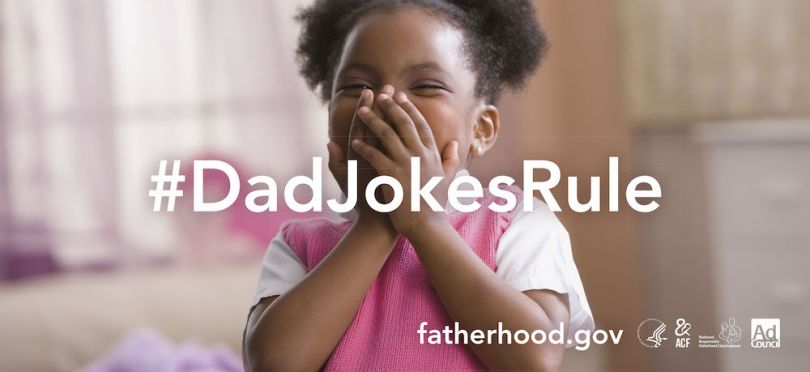
Additional organizations that support fathers include:
Recruiting Trends - May 2019
This update covers recruiting trends from hiring mothers who have career gaps to seeking skilled military veterans and young professionals without college degrees. We’ll also touch on trends in migrating tech scenes and the importance of a well lit office.
Externships for Returning Mothers

70% of mothers with children younger than 18 were in the workforce in 2015, a significant increase from 47% in 1975. Not only that, but 40% of mothers are primary breadwinners, meaning they contribute the largest portion of income to the family, which also includes the 24% of badass single mothers raising kids on their own.
In addition to the mothers currently working, there is a significant number of mothers who have taken time off to care for their children and are looking to jump back into their career. And with the unemployment rate at an all-time-low, employers are finally getting more serious about tapping into this pool of highly qualified candidates.
Major companies like Apple, Walmart and Goldman Sachs are offering opportunities to help individuals, typically mothers who have been out of the workforce for several years, ease back into their career with a returnship or externship. Another company created a specific Enternship for women over 40 to reenter the workplace with a six-week program in which they’re brought up to speed on social media, tech, public relations and networking.
If you’re not sure where to start, consider partnering with one of the many organizations bridging the gap between highly qualified mothers looking to return to their career and companies looking to hire top talent.
Returnship or Externship organizations for mothers
- The Mom Project, Path Forward, Hire My Mom, iRelaunch, reachHire, RebootAccel, The Second Shift, Apres Group and more.
No Degree, No Problem

The average cost of a four-year college degree continues to rise, leaving recent grads who took out loans to pursue their dreams with a steep $29,800 of debt as of 2018. Not surprisingly. Many talented young professionals are looking for alternative career paths that don’t require such exorbitant costs. On the flip side, employers are creating opportunities to help such professionals bypass college in exchange for applicable experiences.
Companies like Apple, Google, Netflix and more are no longer requiring candidates to complete a Bachelor’s or Master’s degree to compete for a role at their company. Which should come as no surprise, considering some of the top tech companies, like Apple and Google, were founded by people who didn’t complete undergrad.
Instead, companies are focusing on experiences as well as hard and soft skills to qualify candidates. Additionally, removing education requirements also allows candidates with more diverse, non-traditional backgrounds to apply.
As of 2015, only 37.7% of Developers completed a Bachelor’s degree, 16.7% started but didn’t complete their degree, 18.4% have a Master’s and 2.2% have a PhD. A large number of people in other technical jobs do not have a four-year college degree, including:
- 17.3% of IT Technicians
- 13.4% of Technical Support Specialists
- 10.8% of Customer Service Representatives
- 10.7% of Network Technological Coordinators
- 9.7% of IT Coordinators
- 9.4% of Marketing Representatives
These represent some of the most in-demand roles out there, so it may be time to rethink your educational requirements the next time you write a job description.
Bye, Bye, Bay

The cost of living in San Francisco is between 2% and 93% more expensive than it is in Austin,
Boston, Chicago, Colorado, LA, NYC and Seattle. To make it worse, it’s not always the best paying city, either.
While San Francisco and Silicon Valley were once the go-to hub for all things tech and innovation, in recent years, tech companies and talent have extended out North, South and East of the Bay area for more affordable, laid-back cities in the US.
And it’s not just the big trendy cities that people are drawn to. Some cities, like Tulsa, Oklahoma, are attracting talented professionals with $10,000+ to move to their quirky little towns. The catch? Professionals have to work full-time remotely for a company outside of the city. Other cities, like St. Clair, Michigan, the state of Maine and more, including some international cities are establishing similar initiatives to keep talented professionals close to home and spending money in the local economy without attracting massive corporations.
On that note, not all cities, *cough New York cough* have been as welcoming to tech giants in recent months and are instead looking for other means of growing their local economy.
Natural Light It Up

Revamping your office space doesn’t have to break the bank. Start by opening the shades.
Among the long list of quirky perks and office designs, natural light is by far one of the most important and sought after elements of workplace environments. A study by Cornell University Professor Dr. Alan Hedge found that employees working in naturally lit offices reported reduced eye strain by 51%, headaches by 63% and drowsiness by 56%.
Another study done by Future Workplace found that employees with access to natural light and views experience improved wellbeing (78% and improved work performance (70%). They also found that employees felt tired (47%) and gloomy (43%) when their office lacked natural light and outdoor views.
Apple Park is a prime example of how a company and building utilizes the local environment and optimizes natural light; just check out this video. The Microsoft Redmond Campus is another example of a company working with nature by building treehouses with WiFi for employees to meet and get out of the traditional office.
If you really can’t avoid fluorescent lighting or you just want to go the extra mile, provide Blue Light Glasses for employees to prevent many of the symptoms that come with traditional office lighting and extensive screen time.
Bring in the Troops

As of April 2019, the unemployment rate for veterans was 2.3%—the lowest month in recorded history— and a stark comparison to the low, yet higher unemployment rate of non-veterans at 4.3%.
Why is that the case, you may ask? Veterans offer a wealth of skills, knowledge and experience that make them exceptional assets to any company and role. If you’re not familiar with military culture, experiences or common military language, you may have trouble connecting their skills to your role. To better understand how military skills are relevant to your role, check out this military skills translator or this skills matcher.
There are several ways that you can build a more inclusive workplace for military veterans. A great place to start is on your careers page and job descriptions. If you have specific educational requirements and years of experience, many veterans will self-exclude themselves from roles they would excel at. Instead, consider using more inclusive language or adding “or relevant military or civilian experience,” and if you have the resources, hire a recruiter who understands military backgrounds.
Additionally, due to their unique career path, many veterans may not have experience writing resumes and cover letters or preparing for an interview. Help bridge the experience gap by offering tips and resources specific to military veterans.
If you’re not sure where to start, learn a few tips for becoming a veteran friendly employer from Military.com and SHRM. You may also look into partnering with organizations that help employers create military friendly workplaces, like BRK Strategies, U.S. Department of Labor, Recruit Military and incorporate military job boards into your recruiting strategy, like Hire Heroes USA, Hire A Veteran, Military Hire, Hire Veterans.
Recruiting Trends - April 2019
It’s April, and you know what that means! The annual H1B visa frenzy has begun and in recent news, the Paycheck Fairness Act passed at last.
This update covers recruiting news from HR’s role in the opioid crisis to the blunt reality of trendy perks and the importance of mental health in the workplace.
HR In The Opioid Crisis

Today, Opioids are dispersed like candy — just about anyone can get them if they reach their hand out far enough and make enough noise. Thanks to low-quality, expensive and volume-driven healthcare, opioids have become a fast and convenient alternative to quality care.
You may be wondering, ‘how is HR remotely related to this national epidemic?’
From 2011 to 2017, workplace overdoses from non-medical use of drugs or alcohol increased by 272%. That figure doesn’t include the number of people who overdosed on opioids outside of the workplace, which accounted for more than 63,000 American deaths and 11.8 million opioid abuse cases in 2016 alone.
The majority of Americans receive healthcare benefits from their employer, which means those of us in the HR space are playing a major (though unintentional) role in the prescription opioid crisis, serving as de facto underwriters of addiction. And aside from the human cost, the opioid epidemic is impacting the nation’s bottomline, as well. Opioid abuse contributes to as much as $42 billion in lost productivity every year.
This is an uncomfortable topic, but it’s crucial that HR take part in the conversation as co-workers are often the first people to notice a problem. If you or anyone you know suffers from addiction, contact the National Drug Helpline at 1-888-633-3239 and learn more about Opioid addiction.
Who Cares About The H1B Visa?

Every April, the U.S. Citizenship and Immigration Service (USCIS) opens 65,000 spots (plus an additional 20,000 reserved for people with master’s degrees) for an H1B, an employment-based, non-immigrant visa for temporary workers. Due to high demand, USCIS implemented a lottery system, and in 2017, the Buy American and Hire American executive order was implemented to offer only “the most-skilled or highest-paid beneficiaries” the H1B visa.
As we’ve previously mentioned, the competition for qualified employees at all levels is at an all time high, and tighter H1B restrictions mean companies looking for talent will need to pay a high price or limit their search to American citizens. These changes have caused international concern, especially for individuals from India and China who are the top recipients of these visas.
The H1B visa program has played a major role in closing the talent gap in the technology sector, especially for companies that sponsor work visas, but the wealth hasn’t been evenly distributed, as giants like Amazon, Google, Microsoft and Intel account for a disproportionate share of these visas. Tighter restrictions will also make it even more difficult for individuals without a master’s degree to earn an H1B. This will certainly have an impact on the tech space, where many employees receive training through non-traditional means (bootcamps, etc.).
Work Less, Pay More

Cool perks like pet-friendly offices and snacks on demand are great, but when it comes down to it, people value their free time more than free beer with colleagues at work on a Thursday evening.
A recent study indicated that the most important benefit among US workers is unlimited time off. Which is ironic, as employees at companies without a minimum time off policy actually take less time off than they would with a set number of PTO days. What can we say? People are fickle creatures.
There has been a significant shift in corporate perk packages as companies realize that investing in snacks and stylish chairs isn’t the same as investing in their employees. Most of those “soft” perks are in place to keep people at work longer, take fewer breaks and ultimately fuse work life with personal life. What ever happened to the separation of church and state?
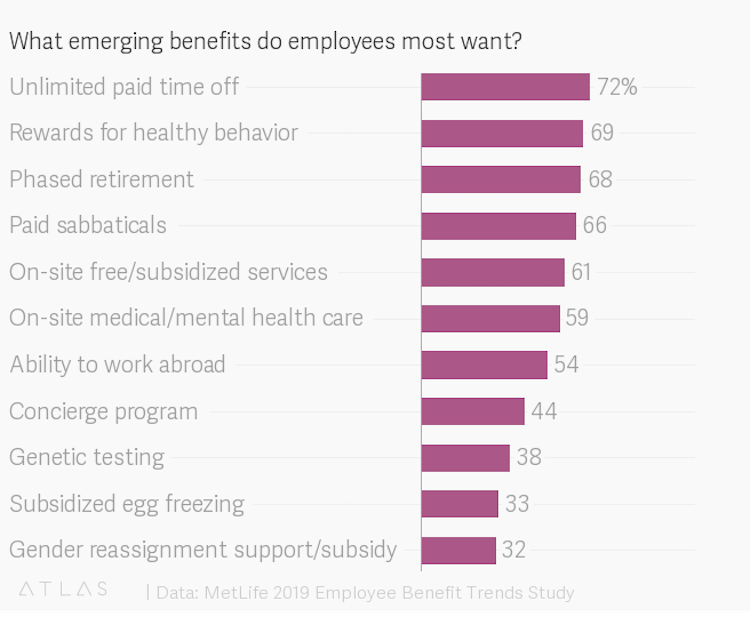
Paycheck Fairness Act Passed

Equal pay is still a hot topic in the workplace because no matter how many Acts America passes, we still can’t seem to get it right. The whole discrepancy is so ludicrous that major name brands are taking a stance on the issue — just take a look at this quick witted video from Kraft Heinz.
The 2019 Paycheck Fairness Act (PFA) (which was first devised in 1997), builds on existing legislation with three key components. First, the PFA prohibits employers from asking job candidates their previous pay. Second, it allows employees to disclose their pay to other employees. Third, it requires employers to disclose their pay information to the Equal Employment Opportunity Commission.
The most recent legislation isn’t the first equal pay effort, and if history is any indication, it probably won’t be the last. Back in 1963, the Equal Pay Act was passed to prohibit pay discrimination based on gender. Then in 2009, the Lilly Ledbetter Fair Pay Act was passed, which also prohibits gender-based wage discrimination and allows workers to sue for discrimination.
If this bill doesn’t have the intended impact, hopefully we’ll see women and minorities taking more advantage of their unlimited time off to even the paying field.
Mental Health Is Employee Health

Employee wellness is becoming a major trend in the HR space, but too often mental health is left out of the conversation. In recent years, American culture has begun to slowly chip away at the stigma behind mental health, shedding light on its significant impact on 20% of the US population.
To help combat the stigma, employers are working to improve resources and insurance benefits to cover mental health services as well as build a more inclusive culture around mental health. Work has a significant psychological impact on employee well-being. Without the support and resources to seek and receive the help employees need, companies may see an increase in absenteeism, work-family conflict, increased mental health and behavioral problems and even higher turnover rates.
If you’re still not sold on the seriousness of mental health in the workplace, consider that America is hit with $193 billion in lost earnings per year due to mental health illnesses.
If you or anyone you know struggles with mental health or if you’d like to be more informed, learn more at National Alliance on Mental Health. You can also call the NAMI helpline at 800-950-626 or text NAMI to 741741.
Recruiting Trends - March 2019
It’s March and the trends in the recruiting and talent acquisition space this month are nothing short of madness.
Given some of the headlines of late, you’d be forgiven for thinking that there hasn’t been much going on, but we’re here to correct that notion.
From female feats and overworked geeks to the future of HR technology, there’s plenty to catch up on.
Who Run The Workplace?

There may still be a prevalent gender gap in the boardrooms of America, but women are making headway in some of the most notoriously male-dominated fields and roles out there.
Take the Fortune 500 companies, for example. In 2018, the number of female CEOs doubled over the course of the preceding decade. Granted, by “doubled” we mean there are now 25 (4.8%) female CEOs in Fortune 500 companies compared to the mere 12 (2.4%) in 2008, but it’s a noticeable shift.
Not only that, but in recent months, women have taken a few first time executive-level roles in the automotive industry, NY Stock Exchange and The Home Depot, industries that are primarily run by and are marketed to men. In addition to the big wigs, smaller companies are also following suit, bringing women onto their executive boards and prioritizing diversity initiatives.
It’s not just women high up in their careers who are making waves. In particular, over the past two years, Millennial women have made a significant change in the employment gap between men and women. Contributing factors likely include some noticeable social, cultural and political shifts that have taken affect in recent history.
In honor of Women’s History month, make sure to celebrate women who have and are taking risks, paving the way for more inclusive opportunities and are supporting other women to reach higher and go farther in their careers.
Office Madness

Last year, 97 million people watched March Madness games across 180 countries.
There’s so much hype around the annual college Basketball tournament that OfficeTeam decided to run a study to see how much the Madness dribbles into the office.
On average, employees spend 25.5 minutes watching sports-related activities each day in the office during the March Madness tournament. Over the course of 15 work days, that’s about six hours spent per employee, amounting to nearly $2.1 billion in lost wages.
While some companies are wary of how the games will affect productivity, last year Warren Buffett, the CEO of Berkshire Hathaway, famously encouraged his employees to take part in the Madness by offering $1M every year for the rest of their life to anyone who accurately predicts all Sweet 16 teams.
Casual Everyday For Everyone

While casual Friday may still be the norm for corporate America, in the startup tech scene, or really anywhere that Millennials dominate the workplace, everyday is a casual day. Whether they’re working from home or in the office, workplace attire and etiquette has drastically changed from the suits and ties of yesteryear.
Now more than ever, candidates care about the culture of the companies they apply to work for, including how people dress and what’s considered appropriate for work. In fact, company culture is the number one factor contributing to a candidates decision to accept an offer.
Not only that, but culture and casual attire are contributing factors to employee morale, happiness and productivity, not to mention the financial burden that comes with updating an additional (and expensive) ‘work appropriate’ wardrobe.
On a more serious note, casual workplace attire has made an impact on the emotional and psychological welfare of employees, especially for those coming from poor, working-class and lower-middle-class backgrounds. Casual dress creates a more inclusive and comfortable work environment for people with diverse backgrounds because employees are less concerned with abiding by the the strict yet ambiguous social and dress codes established by... well...The Man.
Even hyper-formal environments like the White House and Goldman Sachs are adopting company-wide casual offices to evolve with workplace trends and attract younger, diverse talent.
Work Work Work Work Work

We’ve all been to those meetings. You know, the ones that always start with “Hi my name is ___, and I’m a workaholic.” No? Well it may be a rising trend in the not too distant future.
And by that, I mean there already is a Workaholics Anonymous organization that supports people recovering from workaholism across the globe. An organization that should be in high demand considering 50% of Americans are self-proclaimed workaholics.
While companies may be looking to recruit professionals devoted to their work and seeking purpose in their next job, they may want to consider the serious negative effects long working hours have on employees’ health and the consequential rise in burnout rate among young go-getters.
Before you throw the overachievers out with the bathwater, there is an argument for healthy workaholism, depending on the type of workaholic. A study distinguished two types of workaholics — engaged workaholics, who take pleasure in their work, remained healthy after working long hours over an extended period of time. Compulsive workaholics, who are not engaged in their work, showed unhealthy physiological symptoms that may lead to long-term effects. Such risks include diabetes, abnormal heart rhythms, heart disease, stroke, metabolic syndrome and psychiatric disorders.
The main difference between the two is that engaged workaholics are able to tune out work once they leave the office or shut their laptop. Compulsive workaholics, however, are unable to turn off work — it’s always on their mind. This can significantly impede on their personal life, negatively affecting relationships, family dynamics and daily functioning.
Not sure if you’re a workaholic? Read up on these 5 indicators.
Need help balancing your work and life? Check out these tips from the Mayo Clinic.
HR Unicorns Taking Flight

Unicorns are the rarest breed of startups, only earning the moniker after reaching $1B in valuation. As of right now, there are only four tech startup Unicorns in the HR field:
- Huike Group, headquartered in Beijing, China, is an HR tech platform that trains software development professionals in Mobile, Cloud and Marketing.
- Zip Recruiter, headquartered in Los Angeles, USA, is a hiring platform that connects businesses with job seekers.
- Gusto, headquartered in San Francisco, USA, is a payroll and benefits platform.
- Zenefits, headquartered in San Francisco, USA, is a payroll and benefits platform.
I know what you’re thinking, really only four? Yup. Of the 327 global startup Unicorns to date, there are only two HR Tech companies and two HR Fintech companies with a valuation of over $1B in the world.
However, the increasing need for better HR solutions with advanced technologies may soon send the HR world for a ride in the cloud(s). When CB Insights partnered with the New York Times in 2015, they created an algorithm that predicted startup Unicorns with 48% accuracy.
Now in 2019, the’ve done it again, and three (more) HR Tech companies are predicted to reach Unicorn status. Here are the HR & Workforce Management companies to keep an eye on.
- Beisen, headquartered in Beijing, China, is a cloud-based SaaS HR platform for talent and performance management.
- Checkr, headquartered in San Francisco, USA, is a background checking service.
- Deputy, headquartered in Sydney, Australia, is a digital scheduling service that coordinates managers and shift workers.
Recruiting Trends - February 2019
Unemployment Crisis or Fake News?

Employment numbers took a hit in January with only 172,000 new jobs created, a considerable drop compared with the 312,000 jobs added in December.
While that’s a significant difference month over month, let’s not forget the 35 day partial government shutdown that ran from December 22 through January 25, which certainly contributed to the conversation.
You may have also heard of an alarming spike in initial unemployment claims in January, but you have to remember that the 350,000 government employees furloughed during that time were considered unemployed.
Before we make any major claims about job creation and unemployment, let's see how the dust settles in February to determine what was shutdown related and what we can expect moving forward.
Soft Skills — A Top Priority

Technology is the future, there’s no doubt about that. But as long as humans are being hired, there will always be a need for the human touch.
With The Rise of Robo-Recruiting, soft skills — like creativity, verbal and visual communication, storytelling, adaptability and listening — are more important than ever. In fact, soft skills are rated the number one workforce trend in 2019.
Unlike hard or technical skills, which can be clearly tested through skills assessments and algorithms, soft skills are difficult to identify on a resume or even in the interview. Yet these are the skills that make a person and team successful.
Think about it, even the most technical companies out there —Netflix, Airbnb and Google — are also known for their creativity, adaptability and storytelling skills.
Relocation Vocation

While remote work is just work, not all jobs offer the same flexibility, making relocation a vital part of the recruitment effort when pursuing top talent. With so many flexible opportunities available, tech in particular is difficult to hire for, and that's before you account for the fact that only 34% of techies even consider relocating when given the opportunity.
To attract candidates and create an opportunity worth relocating for, companies have put a lot of time and money into offering top benefits for employees and families as well as elaborate perks to set them apart from competing offers.
Companies are also investing in bringing their offices to talent, like Salesforce and Apple to make it more convenient and cheaper for talent to relocate. This is especially appealing for tech talent looking for the opportunities that tech giants have to offer who don’t want to take on the burden of living in exorbitant locations, like Silicon Valley or New York City.
A $4B Hangover

Perhaps in response to the lowest-scoring game in Super Bowl history, Americans felt their game day regrets the following Monday when 17.2 million people called in ‘sick,’ amounting to more than $4 billion in lost productivity.
Ironically, that’s about how much politicians stammered over for more than a month during the government shutdown and aforementioned decrease in January jobs created. They're not the only ones in need of a timeout during the first quarter.
The real question is, at what point do we throw in the towel and make Super Bowl Monday a national holiday for the hungover?
Recruiting Trends - January 2019
New Year, Same Competition

To say that things are a little uncertain at the moment would be an understatement.
At the time of publication, the U.S. government remains in a partial shutdown, the United Kingdom may or may not be leaving the EU (it’s complicated), markets are in a state of flux and geopolitical tensions are high.
As people start to whisper the dreaded “recession” word, you may be thinking that recruiters will soon be back in the driver’s seat, but you’d be wrong.
As the markets were busy freaking out in December, the U.S. economy added more than 300,000 new jobs, marking the second best month of the year. In total, nearly 3 million jobs were created in 2018 (pending review of November and December data), bringing the unemployment rate down to 3.9%.
2019 looks to hold much of the same.
Some forecasts predict the unemployment rate will fall as low as 3.4% by year’s end, with hiring demand set to outpace new entrants to the labor force by a fairly wide margin. What’s more, salaries could increase by as much as 3.5% over the next 12 months.
While predicting the future is a fruitless endeavor, current signs point to another competitive year for recruiters in 2019.
The Rise of Robo-Recruiting

Recruiters, welcome to the fourth industrial revolution.
Recruiting has traditionally been a high-touch process with limited options for automation, but the rapid advancement of technology is opening new frontiers.
Artificial intelligence (AI) is taking the world by storm, and the recruiting industry is getting in on the action. While most of the technology occupies relatively niche spaces (e.g., recruiting chatbots and personal assistants), the rise of algorithmic candidate matching can’t be ignored.
Candidate matching tools utilize AI and machine learning to identify ideal candidates for specific roles, eliminating much of the upfront work associated with the recruitment process. These tools are able to crawl the web 24 hours a day, sourcing millions of top candidates from around the world.
And if that weren’t enough, recruiters may have to get comfortable with the idea of spending a large portion of their time wearing an Oculus Rift, as virtual reality (VR) is also making inroads into the recruiting space.
Jaguar Land Rover recently made headlines for making its first hire through a mixed-reality app, and if the numbers are any indication, it won’t be the last. The auto manufacturer created a code-breaking puzzle that has attracted more than 40,000 participants to date, making excellent use of both VR and gamification.
VR is also being used to onboard and train employees, creating opportunities to gain efficiency and improve safety. Companies like Boeing and Walmart have embraced the technology as a core component of the training process, and both claim positive results.
As cutting edge as VR may seem, it’s actually been utilized by recruiters for quite some time. Lloyd’s Banking Group has utilized VR in its application process for several years, calling it a way to gauge applicants in a manner "that would otherwise be unfeasible in the conventional assessment process."
The verdict is still out on VR’s long-term future in the recruiting space, but it’s clear that companies are more than willing to embrace technology in the pursuit of a sustainable recruiting advantage. If recruiting technology isn’t part of your 2019 budget, you may want to go back to the drawing board.
Tech Turnover Still Going Strong

If you’re a recruiter, you likely spent much of 2018 seeking out qualified tech talent and pitching them on open roles at your company. Well, get ready to repeat the process in 2019, but not because of growth but because of turnover.
The technology sector boasted the highest turnover rate in 2018, and due to the driving factors behind it, we expect much of the same in 2019. Let’s start with the numbers.
In 2018, the technology industry experienced an average turnover rate of 13.2%, led by UX designers, data analyst and embedded software engineers. In fact, the average tenure of employees at many of the world’s biggest technology companies is 24 months or less.
So what gives? Why are some of the world’s most valuable companies struggling to hang on to their people? Well, it’s the same reason that every recruiter is struggling to hire tech candidates in the first place: competition.
There are more technology jobs than there are qualified candidates, leading to intense recruiting and poaching efforts. The best software engineers are able to job hop to their heart’s content knowing full well that they’ll still be just as in demand.
A rash of negative publicity within the technology sector over the past 12 months hasn’t helped either. PR nightmares at companies like Uber, Facebook and Google (to name a few) also had plenty of people looking for new opportunities, and with demand so high, they likely weren’t looking for long.
Retention isn’t typically the responsibility of talent acquisition professionals, but given the amount of work it takes to hire software engineers in the first place, it may behoove them to do whatever it takes to hang on to top talent, as finding a replacement won’t be fun.
Remote Work Is Just Work

Looking for a solution to that aforementioned retention issue? Try implementing a remote work policy.
The rise of remote work has been one of the most pervasive and successful recruiting experiments of the past decade, and it shows no sign of stopping anytime soon. The number of full-time, non-freelance remote workers has increased by 140% since 2005. due in large part to the fact that it just makes sense.
Don’t believe us? Let’s look at the facts.
To start with, remote work policies open a literal world of possibilities when it comes to recruiting. If employees can work from anywhere, companies can recruit from anywhere, making geographical limitations and relocation packages a thing of the past.
Additionally, remote work policies can offer significant savings opportunities as well. Dell reports having saved more than $12 million a year in reduced office space costs.
But it isn’t all about the bottom line. Remote work policies are playing a significant role in closing the gender gap in tech as well. 51% of women say being a working mother makes it difficult to advance in their careers. Flexible work options could eliminate that issue all together.

![2020 Recruiting Trends [Q2 and COVID-19 Updates] recruitment-trends-2020](https://cdn.builtin.com/cdn-cgi/image/f=auto,fit=cover,w=320,h=200,q=80/sites/www.builtin.com/files/recruitment-trends-2019-00.jpg)



